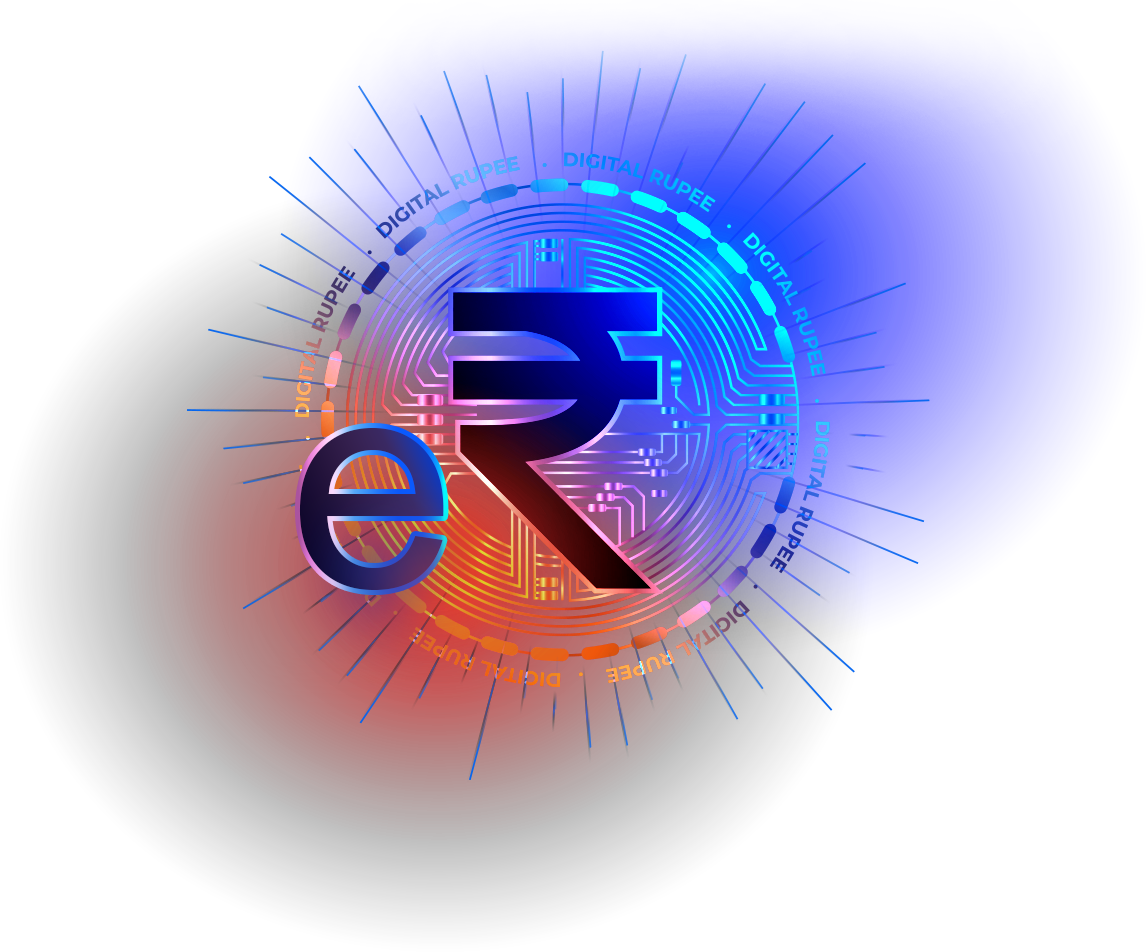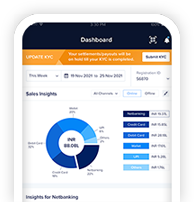What is a Central Bank Digital Currency (CBDC) or
Digital Rupee or e₹ ?
What is a Central Bank Digital Currency (CBDC) or Digital Rupee or e₹ ?
Central Bank Digital Currency (CBDC) or Digital Rupee or e₹ is a
legal tender, similar to sovereign paper currency, issued in digital form by the Reserve
Bank of India. e₹ will offer features of physical cash like trust, safety and
settlement finality with immediate settlement of transactions in digital mode. e₹
represents a direct claim on the central bank. It can be used to carry out transactions or
store value digitally, similar to the manner in which currency notes can be used in physical
form. At present, customers will be able to hold Digital Rupee and transact through a
digital wallet offered by the participating banks.
Is the Digital Rupee a replacement for cash, debit cards or
credit cards?
Is the Digital Rupee a replacement for cash, debit cards or credit cards?
Reserve Bank of India states that e₹ is aimed to complement and create an alternate to
physical currency and not replace current forms of money.
Where can Digital Rupee be held?
Where can Digital Rupee be held?
e₹ can be held in a digital wallet issued by the participating banks. The e₹
wallet or the digital wallet is a digital representation of your physical wallet, which will
store your digital currency. e₹ can be withdrawn/deposited from your existing
savings/current bank account which is linked to your digital wallet.
How is e₹ different from UPI or other fund transfer mode
such as NEFT/RTGS/IMPS?
How is e₹ different from UPI or other fund transfer mode such as
NEFT/RTGS/IMPS?
- e-Rupee is legal tender, not a payment medium
e-Rupee is an electronic form of sovereign currency while UPI applications such as
Google Pay, PhonePe, NEFT, and RTGS are different methods of transferring funds or
payment mediums.
The key difference between Digital Rupee and UPI is that Digital Rupee is a store of
value like currency and UPI is just an overlay infrastructure on top of any form of
store of value like bank accounts (which have normal currency), prepaid instruments,
credit cards, etc. UPI can be an overlay on any store of value. The e-Rupee is a
store of value that can be transferred digitally instantly with finality of
settlement.
- No intermediation of banks
Digital transactions in UPI or NEFT or RTGS must go through a bank while in the case
of the e-Rupee, the money is transferred from one digital wallet to another digital
wallet, and there is no routing or intermediation of the bank.
Who can use the Digital Rupee?
Who can use the Digital Rupee?
At present, customers will be able to transact using the Digital Rupee through a digital
wallet linked to their savings/current bank account offered by the participating banks in
the first phase of the pilot programme such as IDFC First Bank, ICICI Bank, State Bank of
India (SBI), and YES Bank. While Bank of Baroda, Union Bank of India, HDFC Bank, and Kotak
Mahindra Bank will join the pilot in the second phase. Currently, customers and merchants in
closed user groups (CUG) in select locations in Mumbai, New Delhi, Bengaluru, and
Bhubaneswar can use retail e-Rupee via the e-wallets of the above-mentioned banks taking
part in the launch.
Is Digital Rupee a cryptocurrency?
Is Digital Rupee a cryptocurrency?
No. e₹ is the same as a fiat currency and it is exchangeable one-to-one with
government-issued money. It is similar to a banknote or coin that we use daily, only it is
in a digital form and has intrinsic value as it represents a claim on the Reserve Bank's
balance sheet. e₹ is issued by the Reserve Bank and is a legal tender. Crypto products
such as Bitcoin on the other hand do not exhibit any features of a currency, do not have any
intrinsic value, are not backed by assets and are not issued by a central trusted authority,
such as RBI.
How can Digital Rupee (CBDC) be used for online retail
payments?
How can Digital Rupee (CBDC) be used for online retail payments?
You can transact in e₹ through your convenient and safe digital wallet offered by
any of the participating banks. This e₹ wallet is like your physical wallet in
digital form, within your bank's app. You can use your bank app to make e₹
payments to merchant's or another individual's e₹ wallet.
To facilitate payments to merchants, CCAvenue offers Digital e₹ as a payment option
on the payment/checkout page. On selecting the option, customer is displayed a unique QR
code, which they must scan from within their digital wallet bank app. Once the
transaction is successful, the digital currency is transferred from the customer's
digital wallet to the merchant's digital wallet.
How to register for Digital Rupee wallet?
How to register for Digital Rupee wallet?
Customers and merchants holding bank accounts with the participating banks will be
presented with the option to create their e₹ wallet linked to their
savings/current bank account. They can follow the banks process to set up this digital
rupee wallet.
How to load the Digital Rupee wallet?
How to load the Digital Rupee wallet?
Loading money in your e₹ wallet is easy and quick. Download the CBDC app and
register with the mobile number linked to your savings/current bank account with the
participating bank. Once you have registered successfully and a wallet ID is created,
you can load the digital wallet by transferring the desired funds from your linked bank
account. After successful PIN verification, the linked account will be debited, and the
e₹ (Digital Rupee) will be credited to your digital wallet instantly.
How to redeem an e₹ wallet and transfer that to a bank
account?
How to redeem an e₹ wallet and transfer that to a bank account?
Redeeming Digital Rupees from the e₹ wallet is a straightforward process. Enter the
amount you wish to redeem, select the linked bank account to be credited and follow the
bank's instructions. After successful PIN verification, the linked account will be
credited with the equivalent amount, and e₹ wallet will be debited instantly.
Is Digital Rupee secure?
Is Digital Rupee secure?
Yes, Digital Rupee is safe and secure. There is a robust cyber-security framework to
ensure that e₹ is kept secure. It provides access to safe money for payment and
settlement as it is a direct liability of the Central Bank. If you lose your physical
wallet, retrieving the same is very difficult, however, in case of Digital Rupee wallet,
the money is safe even if the device on which the wallet is saved, is lost as the same
is protected by PIN and can be retrieved.
How many digital wallets can be used by a single user?
How many digital wallets can be used by a single user?
One user can have only one digital wallet with one participating bank, which is linked to
their savings/current bank account. However, he can have multiple digital wallets with
various other participating banks with whom he holds his savings/current bank account.
Is there a minimum balance required to open/maintain the
e₹ wallet?
Is there a minimum balance required to open/maintain the e₹ wallet?
No. There is no minimum balance required to open/maintain e₹ wallet.
Are there any limits applicable on e₹ wallets and usage?
Are there any limits applicable on e₹ wallets and usage?
e₹ can be used 24 hours, 7 days a week and 365 days a year. However, there are some
limitations on the holding capacity, volume and value of transactions, defined by each
participating bank.
Is the Digital Rupee accepted globally?
Is the Digital Rupee accepted globally?
Digital Rupee works exactly like the fiat currency and it is exchangeable one-to-one with
government-issued money. Currently global transfers through e₹ wallet is not
available.
Is Digital Rupee transferable or exchangeable between the
participating banks?
Is Digital Rupee transferable or exchangeable between the participating
banks?
Digital Rupee is interoperable between the participating banks. For instance, a user can
transfer e₹ from his bank's e₹ wallet to another user's e₹ wallet in
another participating bank.























 INFIBEAM
AVENUES
INFIBEAM
AVENUES